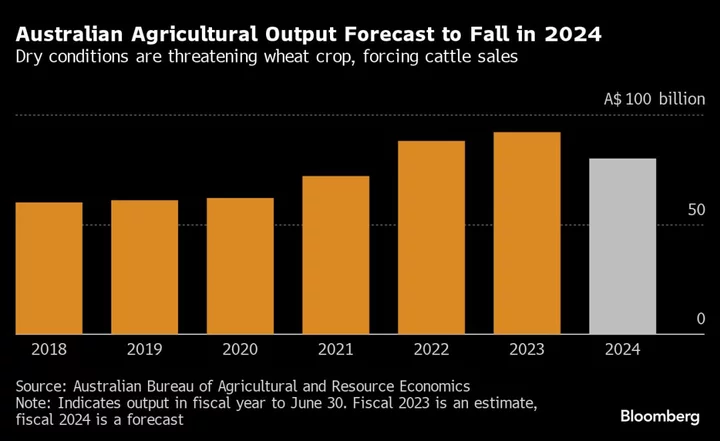Droughts and forest fires are among threats that may scupper Australia’s ambitions to bolster its farming sector into a A$100 billion ($64 billion) powerhouse by the end of the decade.
The country just recorded its driest-ever September, which is jeopardizing the wheat harvest and forcing farmers to sell cattle. This summer’s bushfire season promises to be worse than usual due to the El Nino weather pattern, while new pests, like the bee-killing varroa mite, are another hurdle.
The government is forecasting the production value of Australian agriculture will drop 14% to A$80 billion in the year through June 2024 due to the drier weather and falling commodity prices. In the longer term, climate change is adding to the challenges. Average rainfall has declined at least 15% over the last half-century, while the bushfire season has become longer and more extreme.
While the A$100 billion goal — first announced in 2018 — might be possible by 2030, it would take a lot of factors like weather and commodity prices to line up, said Michael Whitehead, executive director of agricultural insights at ANZ Group Holdings Ltd.
“When we got close to a A$100 billion last year, it was due to a perfect storm of circumstances,” he said. There’s a “strong possibility” that won’t happen again for years, if not decades, he said.
The A$92 billion generated from agriculture in the year through June 2023 was a record, aided by the war in Ukraine boosting wheat prices. Cattle prices were also at historically high levels as farmers restocked their herds following a drought. One of the world’s biggest meat and grain exporters, agriculture accounted for 2.4% of Australia’s GDP in 2021-22.
Hundreds of growers and industry experts will gather at the National Farmers Federation conference in Canberra from Thursday to discuss the challenges. Tony Mahar, chief executive of the industry body, said some downgrades to revenues should be expected over the next few years, with the livestock and grains sectors likely to be hardest hit.
Read more: Extreme Weather Turns Up the Heat on Investing in Agriculture
“We’re probably going to take a dip in the next year or so given prices have come off significantly and if we believe it’s going to be a hot and dry period, then that means production will come down as well,” Mahar said. Still, he said he remained optimistic that the industry would be able to meet, if not exceed, the 2030 production target.
While climate change is threatening Australia’s agricultural revenue, the nation is still one of the biggest coal and natural gas exporters. The election of Prime Minister Anthony Albanese’s Labor government last year had raised optimism its reliance on fossil fuels would be lessened, but that’s been dimmed by approvals to four coal projects since it took office.
Some farmers are more concerned with staying afloat than with the government’s lofty production goals. Justin Everitt, who grows wheat, canola, barley and lupins in northern New South Wales, said he was likely to produce 20% less grain this year after his crops had started to rapidly dry since August.
“It’s nice to aim for big targets, but we need to make sure our farms are profitable first,” he said.
--With assistance from Ben Westcott.

